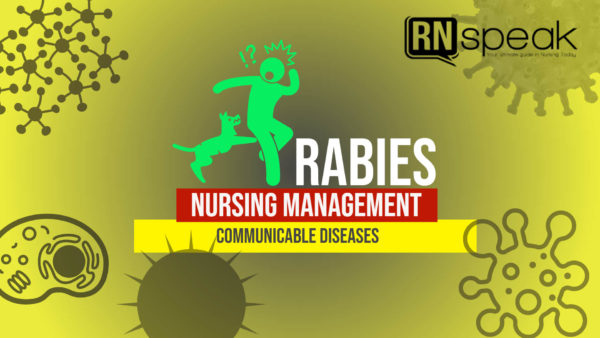Rabies is a human infection that occurs after a transdermal bite or scratch by an infected animal, like dogs and cats. It can be transmitted when infectious material, usually saliva, comes into direct contact with a victim’s fresh skin lesions. Rabies may also occur, though in very rare cases, through inhalation of virus-containing spray or through organ transplants.
Rabies is considered to be a neglected disease, which is 100% fatal though 100% preventable. It is not among the leading causes of mortality and morbidity in the country but it is regarded as a significant public health problem because (1) it is one of the most acutely fatal infections and (2) it is responsible for the death of 200-300 Filipinos annually.
Mode of transmission
When the virus first enters the body via an infected bite, it first spreads from the inoculum region to the spinal cord and onto the brain. After replication in the brain, the virus travels outward to many locations of the body, including the salivary glands and corneal epithelial cells. The most interesting characteristic of the rabies virus is that it infects the brain, causing the animal to want to bite, and then concentrates itself in the salivary glands to ensure transmission its next host.
Sign and Symptoms
| Animals | Human |
| may appear sick, crazed, or vicious (“mad dog”) | pain, tingling, and/or itching at bite site. |
| may also appear overly friendly, docile or confused | – nonspecific – fever, chills, fatigue, muscle aches |
| nocturnal animals alert during the day | later – high fever, agitation, confusion |
| extreme hydrophobia and aerophobia | |
| death during later stages |
Incubation period
The usual incubation period is 2 to 8 weeks. However, It can also belong for a year it depends on the severity of the wounds and the resistance of the host.
Period of communicability
The patient is communicable 3 to 10 days before the onset of symptoms until the entire course of illness.
Diagnosis
No tests are available to diagnose rabies infection in humans before the onset of clinical disease, and unless the rabies-specific signs of hydrophobia or aerophobia are present, the clinical diagnosis may be difficult. Post mortem, the standard diagnostic technique is to detect rabies virus antigen in brain tissue by fluorescent antibody test.
Treatment
Once symptoms for rabies appear, there is no treatment. However, a vaccine can be administered after an exposure (postexposure prophylaxis). The indication of vaccination depends on type of contact with the rabid animal.
| Category of exposure to suspect rabid animal | Post-exposure measures |
| Category I -touching or feeding animals, licks on intact skin | None |
| CategoryII -nibbling of uncovered skin, minor scratches or abrasions without bleeding | Immediate vaccination and local treatment of the wound |
| Category III- single or multiple transdermal bites or scratches, licks on broken skin; contamination of mucous membrane with saliva from licks, exposures to bats. | Immediate vaccination and administration of rabies immunoglobulin; local treatment of the wound |
Recommended Postexposure Prophylaxis Administration
A patient who is exposed and has never been vaccinated against rabies should give Intramuscular (IM) of rabies immune globulin (RIG) on day 0, give 1 mL of rabies vaccine on days 0, 3, 7, 14, and 28. If the patient has previously vaccinated with a cell culture vaccine and previously demonstrated rabies antibody he/she should receive 2 IM doses of 1 ml each, one immediately and one 3 days later.RIG should not be given.
Note: Administer IM in the deltoid area in older children, adults, and in the mid-lateral aspect of the thigh in young children. Never administer rabies vaccine in the gluteal area this may result in an inadequate immune response. Post-exposure prophylaxis dose must be given as soon as possible.
Rabies Nursing Management
- Provide patient Isolation
- Wash hands before and after patient contact to prevent self-contamination and spread of disease
- Give emotional and spiritual support to the family by helping them cope with the patient’s symptoms and probable death
- Darken the room, provide a quiet environment
- The patient should not be bathed and must not have any running water in the room.
- Continuously monitor cardiac and respiratory function








